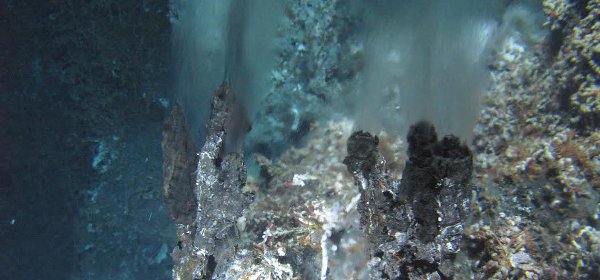
April 1, 2020
Research Highlight
Draft Genomes of Two Unique Bacteria
Two separate studies provide genomes of a sulfur-disproportionating bacteria and a novel thermophilic bacteria.

A view of a hydrothermal vent at the Main Endeavour Field on the Juan de Fuca Ridge, snapped from the submersible Alvin.Image credit: Woods Hole Oceanographic Institution.
Two research teams supported in part by the NASA Astrobiology Program have published draft genome sequences of unique types of bacteria isolated from natural environments. The first sequence comes from Desulfovibrio sulfodismutans ThAc0, which was isolated from freshwater mud. This was the first organism found to be capable of growing by disproportionation of either sulfite or thiosulfate to sulfide and sulfate. Dispropotionation is a type of reaction by which a substance is both oxidized and reduced to produce two separate products. Sequencing of D. sulfodismutans is part of a larger effort to identify genetic markers that can be used to distinguish between sulfate-reducing organisms and sulfur-disproportionating organisms.
The second sequence comes from a bacteria that was collected in hydrothermal vent fluids at the Juan de Fuca Ridge. Desulfurobacterium sp. strain HR11 was isolate at relatively low temperature (19°C) and its 16S rRNA gene sequence is 99.3% similar to the organism Desulfurobacterium thermolithotrophum BSAT. This percentage is above the threshold of similarity for defining a new species. However, distinct differences can be seen between BSA and HR11, including the ability of HR11 to reduce nitrate and its inability to reduce sulfite. The research team sequenced the genome of HR11 and found that the overall genome relatedness index (OGRI) does indeed indicate that HR11 is a novel species.
Astrobiologists study the myriad of ways in which microorganisms on Earth produce energy and grow because this research can help us understand how life as we know might gain a foothold on other terrestrial planets. Microorganisms on Earth have developed a wide range of mechanisms for surviving in the harshest environments our planet has to offer. Understanding these mechanisms, the evolutionary steps that allowed for their development, and the larger affects they have on aspects of our planet (such as atmospheric and ocean chemistry) can inform our search for the signatures of past or present life on other worlds.
The papers, “Draft Genome Sequence of Desulfovibrio sulfodismutans ThAc01, a Heterotrophic Sulfur-Disproportionating Member of the Desulfobacterota” and “Draft Genome Sequence of Desulfurobacterium thermolithotrophum Strain HR11, a Novel Thermophilic Autotrophic Subspecies from a Deep-Sea Hydrothermal Vent,” were published in the journal Microbiology Resource Announcements. These studies were supported by NASA Astrobiology through the Exobiology Program. This newly-revealed science is also a critical part of NASA’s work to understand the Universe, advance human exploration, and inspire the next generation. As NASA’s Artemis program moves forward with human exploration of the Moon, the search for life on other worlds remains a top priority for the agency.